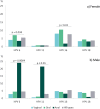Sexual practices and HPV infection in unvaccinated young adults
- PMID: 35859090
- PMCID: PMC9300667
- DOI: 10.1038/s41598-022-15088-8
Sexual practices and HPV infection in unvaccinated young adults
Erratum in
-
Author Correction: Sexual practices and HPV infection in unvaccinated young adults.Sci Rep. 2022 Aug 25;12(1):14508. doi: 10.1038/s41598-022-18818-0. Sci Rep. 2022. PMID: 36008562 Free PMC article. No abstract available.
Abstract
The present study aimed to evaluate the association of genital and oral HPV infection among different sexual practices in both sexes. In total, 6388 unvaccinated men and women aged 16-25 years from all state capitals of Brazil were enrolled in through primary care services between September 2016 and November 2017. Genital and oral HPV genotyping was performed using the Roche Linear Array. Poisson regression analysis with robust variance was conducted to examine factors associated with overall HPV infection. A higher prevalence of genital HPV was found in women who practiced oral sex (57.85%) and in men who practiced all types of sex (65.87%). However, having more sexual partners and being younger were more important than the type of sex practiced. HPV 6 (7.1%) and 16 (10.5%) were significantly more prevalent in women who practiced oral sex, while HPV 6 (23.96%) and 11 (21.49%) were more prevalent in men who practiced anal sex. The type of sex was not associated with oral HPV prevalence. Genital and oral HPV infection were not associated by different sexual practices in the studied population.
© 2022. The Author(s).
Conflict of interest statement
LLV is a member of the Board for HPV vaccines for Merck, Sharp & Dohme and a consultant for BD, Roche and Qiagen for HPV tests. All other authors have completed and submitted the COI-corresponding author form for Disclosure of Potential Competing interests, and none were reported.
Figures
References
Publication types
MeSH terms
LinkOut - more resources
Full Text Sources
Medical


